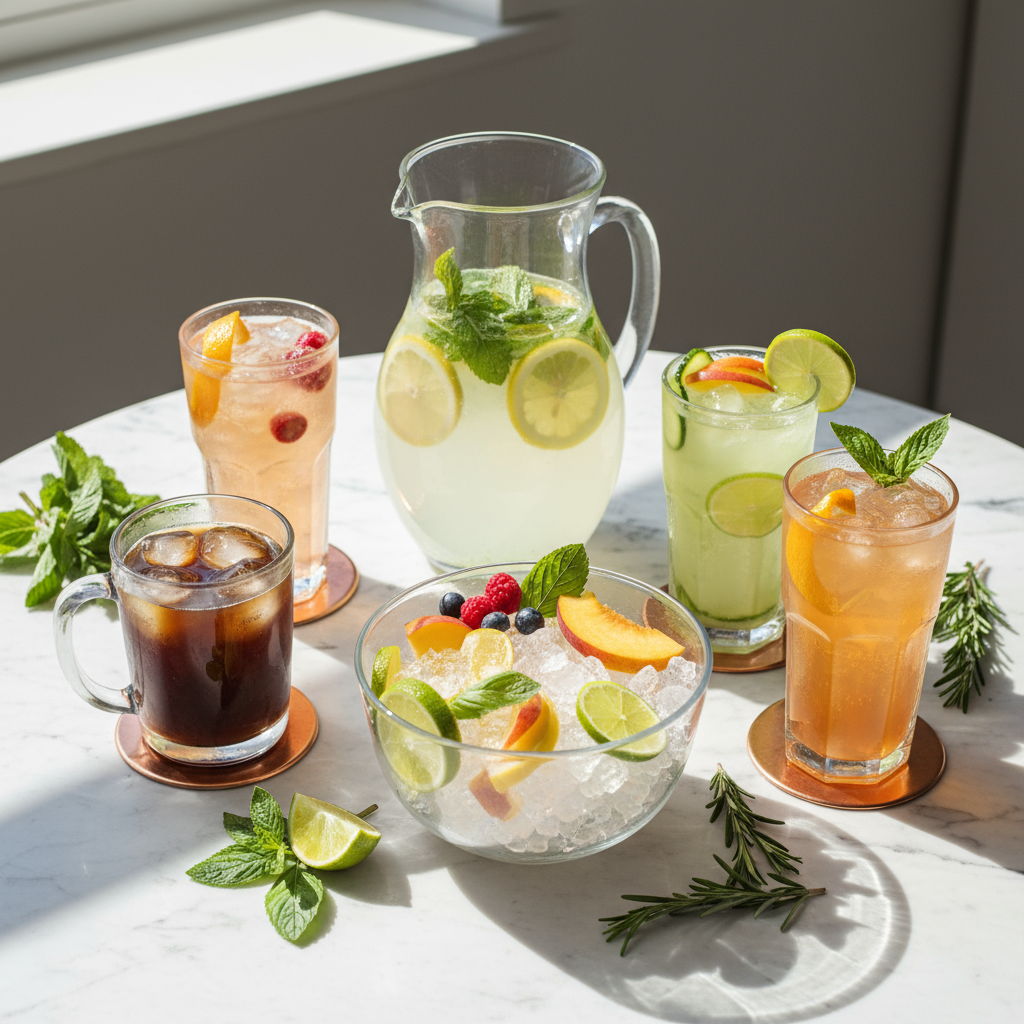Summer drinks are my favorite way to stay cool, social, and hydrated. When the heat hits, I reach for simple templates I can tweak fast: citrus, herbs, bubbles, and good ice.
I keep a pitcher base in the fridge, then add fizz at serving so every glass stays crisp. If I want light sweetness, I use half-sweet syrups or fruit purées.
For hydration, coconut water, a pinch of salt, and plenty of citrus do the heavy lifting. Friends who skip alcohol get full-flavor mocktails, and anyone who wants a spritz can add wine, vermouth, or a zero-proof swap.
Rotate iced teas, cold brew coffee, and aguas frescas, because variety keeps cravings in check. Garnishes matter: mint, citrus wheels, and frozen fruit pull double duty as décor and chill.
With a few smart swaps and easy batching, I can serve a crowd without stress and enjoy the evening with friends.
What I mean by “summer drinks”
When I say summer drinks, I mean cold, bright, and easy to sip. They rely on ripe fruit, fresh herbs, and plenty of ice.
The flavors feel clean, with balanced sweet, sour, and a little bitterness. I build them so they refresh first, impress second.
What makes them seasonal
Seasonality starts with produce. Citrus, berries, and melons taste better and cost less in warm months.
Herbs like mint and basil grow fast, so I use them by the handful. I keep textures light: shaken, stirred, or lightly blended.
Fizzy water adds lift without heavy sugar.
My goals for every recipe
- Thirst-quenching: High water content, crisp acid, and minimal heaviness keep you drinking.
- Low effort: Short ingredient lists and simple methods reduce prep time.
- Scalable: Pitcher-friendly bases let me serve two or twenty without stress.
- Flexible: One template, many variations, so I can swap fruit or herbs fast.
Options for every guest
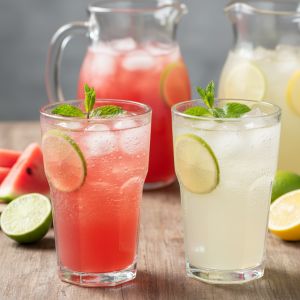
I plan for both non-alcoholic and alcoholic paths. I pour full-flavor mocktails that never feel like “the kid’s drink.”
If someone wants a lift, I offer wine, vermouth, or a measured spirit topper. Zero-proof aperitifs make it easy to keep complexity without alcohol.
Health-forward by default
I lead with lower sugar, then adjust to taste. Fresh citrus sharpens flavor so I can use less syrup.
A pinch of salt boosts perception of sweetness and supports hydration. Coconut water or a splash of fruit juice adds electrolytes without turning the drink into dessert.
Real-world examples
For a park picnic, I bottle a lemon-mint base and add sparkling water on site. For a family barbecue, I set a self-serve iced tea station with peach syrup and lemon wheels.
At a weekend brunch, I blend a watermelon-lime agua fresca and keep vodka on the side.
How this guide helps
You’ll get templates, not rigid recipes. You’ll see how to batch, chill, garnish, and scale.
You’ll serve drinks that stay cold, taste balanced, and make hosting easier.
Core Ingredients and Smart Substitutions
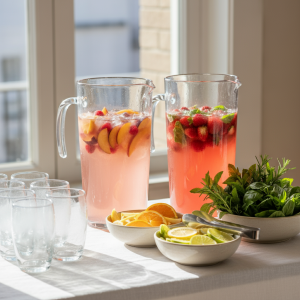
Fresh produce that does the heavy lifting
Citrus: Lemon and lime bring clean acidity that makes everything pop. I aim for 15–30 ml (1–2 tbsp) fresh juice per serving, then adjust. Roll fruit on the counter before juicing for more yield. Zest adds aroma without extra sourness, so I use a little in syrups.
Berries: Strawberries and raspberries taste great, but seeds can turn drinks gritty. I muddle gently, then fine-strain, or cook a quick berry syrup for a smoother finish. Frozen berries are perfect for budget batches and keep flavor consistent.
Melons: Watermelon and cantaloupe add body without heavy sugar. I blend and strain for a bright juice, then balance with lime. Frozen melon cubes work as “ice” that won’t dilute.
Herbs: Mint, basil, and rosemary change a drink fast. I never pulverize mint; I smack the sprigs to release oils, then stir. For stronger flavors, I cold-infuse herbs in syrup for 4–12 hours to avoid bitterness.
Real-world swap: If strawberries taste flat, I add 1–2 tsp lemon juice and one pinch of salt to lift the flavor instead of dumping in more sugar.
Liquids that set the base
Still and sparkling water: Filtered still water keeps flavors clean. For bubbles, I top with chilled soda water at service so the fizz sticks around.
Cold brew tea: I use 8–10 g loose tea per 1 L cold water (or 3–4 tea bags), steep 6–12 hours in the fridge. Cold brew stays smooth and less bitter than hot-brewed, which helps when I cut sugar.
Cold brew coffee: A 1:4 ratio (coffee to water by weight) makes a concentrate that lasts 5–7 days chilled. I dilute to taste with milk, alt-milk, or water over ice.
Coconut water: It adds gentle sweetness and around 400–600 mg potassium per cup, which supports hydration. I mix half coconut water, half sparkling water for a lighter profile.
Fruit purées and fresh juices: Purées add texture; juices add brightness. For aguas frescas, a simple 1:1 juice to water base gives a refreshing starting point.
Real-world swap: If iced tea tastes thin, I blend in 100 ml peach nectar per liter, then sharpen with a squeeze of lemon.
Sweeteners that don’t steamroll flavor
Simple syrup (1:1): Dissolve equal parts sugar and hot water by weight. It blends fast and keeps one to two weeks chilled.
Rich syrup (2:1): I use this when I want less dilution in shaken or blended drinks.
Honey or agave syrup: I cut them 1:1 with hot water so they mix cleanly. Honey brings floral notes that taste great with lemon and thyme.
Flavored syrups: Ginger, hibiscus, vanilla, or lavender change the vibe without extra work. I simmer spices or flowers gently, then cool and strain.
Low-sugar options: Erythritol or monk fruit can stand in for part of the sugar. I start at 50% replacement, then tweak. A pinch of salt often reduces the need for more sweetness.
Evidence-backed tip: Acidity increases perceived sweetness. I add 5–10 ml lemon or lime, taste again, and only then adjust sugar.
Smart substitutions for every guest
Dairy to non-dairy: Coconut milk adds silky body to smoothies and frozen drinks. Oat milk stays neutral for iced coffee and chai. Almond milk keeps things light but can split with acid, so I add it last.
Soda to seltzer: Flavored seltzers give aroma without syrupy aftertaste. I like citrus or berry seltzers as toppers to keep sugar in check.
Spirits to zero-proof: I keep complexity with non-alcoholic aperitifs, verjus, or a quick shrub (vinegar + fruit + sugar). Bitters often contain alcohol, so for alcohol-free crowds I use glycerin-based bitters or strong tea for tannin.
Sugar-heavy mixers to better bases: I replace store lemonade with a fresh lemon-simple base (2 parts water, 1 part lemon juice, 0.75–1 part syrup), then customize with herbs.
Real-world example: For a mixed crowd, I build a strawberry-basil lemonade base in a pitcher. Guests who want alcohol add a 30 ml shot of gin or a splash of dry vermouth. Everyone else tops with soda water. The flavor stays identical; the ABV is their choice.
Ice, Chilling, and Texture
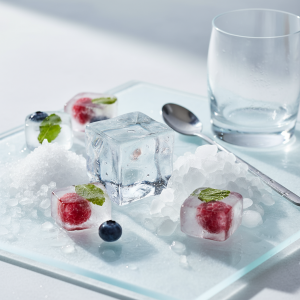
Choose the right ice
Standard cubes: Reliable and easy. I fill trays with filtered water so off flavors don’t creep in.
Large cubes or spheres: Slow melt and clean look. I use these for spritzers and spirit-forward highballs to keep flavors tight.
Crushed or pebble ice: Fast chilling with intentional dilution. I reach for it when drinks are sweet, spicy, or high-proof because the extra melt balances them.
Infused ice: I freeze mint, citrus peels, or berries into cubes for subtle aroma and a pretty finish.
Clear ice, simple method: I use a small insulated cooler, fill with water, freeze uncovered, then cut off the clear top block. Directional freezing pushes the cloudiness down, so the top stays crystal clear.
Keep everything cold without watering down
Pre-chill gear: Glasses, pitchers, and soda water go in the fridge at least 30 minutes before serving. Cold vessels mean less ice melt on contact.
Chill the base, add bubbles last: I keep concentrates in the fridge and only top with soda at the pour. Fizz holds longer in colder liquid.
Frozen fruit as ice: Watermelon, pineapple, or grapes work as edible cubes. They keep flavor strong and add texture.
Salted ice bath for bottles: For a rapid chill, I nestle sealed bottles in a bucket of ice, water, and a handful of salt. The brine drops the temperature quicker than plain ice.
Two-ice system: I use cheaper “working ice” for shaking or stirring, and a clean tray of “presentation ice” for serving. The final glass stays pristine.
Dial in texture like a pro
Shaken: Best for citrus, dairy-free sour styles, and herbal mixes. Shaking adds air and brightness. For a soft foam without alcohol, I use 10–15 ml aquafaba per serving and shake hard.
Stirred: Smooth and glossy. I stir tea-based highballs or coffee drinks when I want clarity and minimal dilution.
Blended: Perfect for slushies and frozen cocktails. I start with a 1:1 ratio of liquid to ice, then pulse and adjust. I add a pinch of salt and a squeeze of citrus so flavors don’t taste dull when cold.
Thickeners: Banana or mango round out fruit slushies. Coconut milk or yogurt adds body to smoothies. I add acid back in (lime or lemon) so thickness doesn’t read as heavy.
Fizzy finishes: I never shake carbonated mixers. I pour them down the side of the glass at the very end to protect bubbles.
Real-world setups that work
Backyard BBQ: I pre-batch a tart lemonade base in a dispenser, park seltzer on ice, and set a bowl of frozen strawberries as “ice.” Guests top to taste.
Balcony spritz hour: I keep a tray of big cubes, chilled wine, and a liter of cold orange-herb syrup. Each glass gets one large cube, 60 ml base, wine, then soda. Zero-proof folks swap wine for tonic.
Kids’ party: I blend watermelon-lime with a touch of honey, then pour over pebble ice. Parents add a splash of ginger beer to their glasses for a spicy lift.
Quick fixes for common problems
- Too watery: Switch to larger cubes, strain melted ice, and pour over fresh presentation ice.
- Not cold enough: Pre-chill the base longer or use a metal pitcher, which drops temperature faster.
- Flat fizz: Add carbonated mixers at the pour, not in the pitcher, and keep bottles capped between rounds.
Sundowner Sips (Alcoholic, Optional)
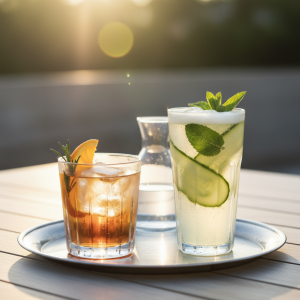
Light spritzers that stay bright
Aperol-style template: I build a balanced spritz with a 3:2:1 ratio: 90 ml dry bubbly (prosecco or soda for lighter ABV), 60 ml aperitif, 30 ml chilled soda water. I pour over a large cube, add an orange wheel, and taste. If it skews sweet, I squeeze in 5 ml lemon for lift.
White wine spritz: I go 1:1 chilled white wine to soda water, then add a thin cucumber ribbon. It stretches a glass of wine, drops the alcohol, and feels extra crisp.
Low-ABV swaps: I love bianco vermouth or dry sherry in place of stronger spirits. Both bring complexity with fewer units. I stick to 75–90 ml fortified wine, then top with soda and citrus.
Real-world move: For mixed groups, I pre-batch the aperitif and citrus in a bottle. Guests add their own bubbles: prosecco, tonic, or soda.
Highballs for effortless refreshment
Gin and tonic riffs: I start with 45 ml gin, 120–150 ml chilled tonic, and lots of ice. For a garden vibe, I add 2 cucumber coins and a mint sprig. Pink peppercorns add gentle heat; I crack three over the top.
Paloma lite: I build 45 ml tequila, 60 ml fresh grapefruit juice, 15 ml lime, then top with soda water. A salted rim lifts the sweetness without more sugar. If I’m pacing, I halve the tequila and it still tastes great.
Evidence-backed tip: Bigger ice melts slower, so the drink stays crisp longer. I use a single large cube for highballs when I can.
Pitcher cocktails that scale cleanly
Stone-fruit rosé sangria (serves 6):
- 1 bottle dry rosé (750 ml), very cold
- 250 ml soda water (add at service)
- 2 peaches or nectarines, sliced
- 1 orange, wheels
- 30–45 ml simple syrup, to taste
- 30 ml lemon juice
I stir fruit, syrup, and lemon, chill one hour, then add rosé. I pour over ice and top each glass with soda so the fizz stays intact.
Pimm’s-style cup (serves 6):
- 300 ml Pimm’s or red vermouth for lower ABV
- 900 ml chilled lemonade or half lemonade, half soda for less sugar
- Cucumber, strawberry, orange, and mint
I add lots of ice to the dispenser, layer fruit, then pour the mix. I tuck in extra mint at the end so it stays aromatic.
Hosting shortcut: I label pitchers with “add soda last” and set a small jug of simple syrup nearby so people can customize sweetness.
Frozen cocktails for peak heat
Frosé, fast track: I blend 500 ml chilled rosé, 250 g frozen strawberries, 20–30 ml simple syrup, and 15 ml lemon. I pulse until slushy and serve immediately. For a make-ahead, I freeze the blend in a shallow tray and scrape before guests arrive.
Frozen margarita, classic or mango:
- 60 ml tequila blanco
- 30 ml lime juice
- 15–20 ml orange liqueur or simple syrup
- 1 to 1½ cups ice
I blend to a smooth pour, then taste. If it dulls when cold, I add a pinch of salt and 5 ml more lime. For mango, I swap half the ice for 150 g frozen mango. For spicy, I blend one thin jalapeño slice, seeds removed.
Zero-proof path: I replace tequila with 60 ml strong limeade and 30 ml verjus or a non-alcoholic agave spirit, then keep the rest identical.
Sensible pacing without losing the party
I alternate cocktails with sparkling water, keep snacks salty-citrusy to sharpen flavors, and pour modest serves over plenty of ice. Lower-ABV choices like spritzes, vermouth highballs, and sherry coolers make it easy to enjoy the evening and still feel good the next day.
Sip Smart, Stay Cool
Here’s the takeaway: summer drinks should be fresh and easy. I keep a few templates on hand, lean on citrus and herbs, and chill everything before I pour.
Lower sugar, smarter ice, and make-ahead bases keep every glass bright without fuss. Whether I mix a spritz, watermelon agua fresca, or peach iced tea, the same rules apply: start cold, season with acid, and add bubbles last.
I taste as I go, adjusting citrus or syrup until the balance lands clean and crisp.
Ready to put this to work? Use the plug-and-play recipes and batching tips to build a menu for your next hangout.
You’ll save time, stay hydrated, and serve drinks that feel thoughtful without extra effort. Pick one base, prep the garnishes, and set out chilled seltzer so guests can customize.
This starter kit makes your summer pours consistent, refreshing, and fun all summer long.

